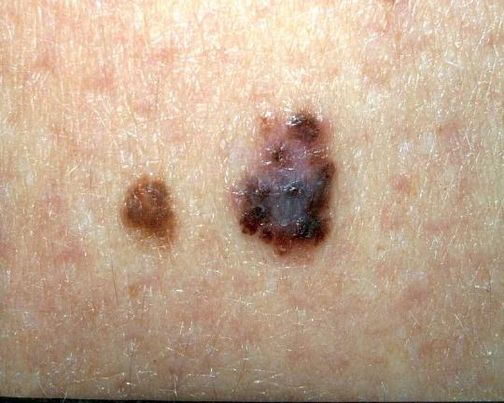Melanoma is the considerably the most serious type of cancer that develops in the melanocytes. Melanocytes are the pigment cells that are responsible in giving color to the skin. Aside from the skin, melanoma may also develop in the eyes and in rare cases, in the intestines.
Melanoma is the most common type of cancer that affects people. Â In United States alone, around fifty thousand new cases are reported each year.
The exact cause of melanoma is not really clear but studies show that severe exposure to ultraviolet rays from direct sunlight, tanning beds and lamps may increase the risk of developing skin cancer. Â Though genetic factors also play a major role.
Minimizing your exposure to tanning beds may lessen the risk of developing melanoma. Â Likewise, detecting the early signs of melanoma is very important. Early detection may make way for successful treatment.
Knowing the signs of melanoma and skin changes related to it is part of early detection. Â If you observe the changes, it is important that you visit your healthcare provider immediately.
What are the signs of melanoma?
Melanoma can develop to any part of the body, though the most common area are the face, arms, back and legs. Â It may also appear in the fingernail beds and palms.
The first sign of melanoma may include:
- Notably physical change in the appearance of existing mole
- Development of unusual growth in the skin
Moles can grow in any part of the body and some individuals may have more than 25 moles. Â Some may turn bigger while some may disappear later on. But not all changes that accompany moles may mean melanoma but it is recommended that you see your dermatologist. Â It is better to detect early than to be sorry later.
Accordingly, the American Academy of Dermatology had made guidelines of signs of melanoma. Â Here are the ABC’s signs of melanoma.
- A for asymmetry. See if the first half of the mole appears the same as the second half.
- B for border irregularity. The border of the moles may appear irregular, notched and uneven. Â This is an alarming sign of melanoma.
- C for color changes. Spots that may appear in different pattern and irregular color than the rest of the mole.
- D for diameter. See if there is new growth in the mole which may appear larger than a pencil eraser.
- E for evolving. Observed if the mole is evolving into something bigger or may become itchy or if bleeding develops over time.
Nobody can really diagnose oneself. Â It is important that you see your healthcare provider to know if your condition is melanoma or just another type of skin problem.
What are the causes of melanoma?
Melanoma develops when the melanocytes is damaged. Â In a normal process, the skin cells are formed in a very controlled manner. Â The healthy skin cells are form and will push the old cells outwardly to the surface of the skin where eventually it is discarded, however, when the new cells encounter damage, they may have excessive growth that may lead to skin growths or changes in moles that may carry cancerous cells.
The exact reasons why the skin cells are damaged are not really known. However, several factors may lead to the development of melanoma. Â The first factor that doctors held responsible for melanoma is severe exposure to ultraviolet rays. Â Genetics and environment also play a great deal in melanoma.
What is the risk factors affecting melanoma?
Risk factors related to melanoma are:
- Those having a fair skin are more susceptible in having melanoma because they have less melanin in the skin. Â Lesser melanin means lesser protection to ultraviolet rays. However, melanoma can also develop to those who have dark complexion.
- Severe sunburn
- If you frequently goes under tanning beds and lamps
- Those people who various normal moles or have several unusual moles
- Those who have family members that have melanoma are at higher risk of developing it too.
What are the Treatments for Melanoma?
1. Immunotherapy
 Immunotherapy is used to boosts the immune system and to aid in fighting the cancer cells. Â These treatments are typically made of the substances that the body produces. Â This is recommended by doctors to melanoma that had metastasized though some side effects like fever and muscle aches are reported.
Immunotherapy is used to boosts the immune system and to aid in fighting the cancer cells. Â These treatments are typically made of the substances that the body produces. Â This is recommended by doctors to melanoma that had metastasized though some side effects like fever and muscle aches are reported.
2. Surgery
 If melanoma had affected the nearest lymph node, your doctor may recommend surgery. Â Your doctor will monitor your condition after the surgery.
If melanoma had affected the nearest lymph node, your doctor may recommend surgery. Â Your doctor will monitor your condition after the surgery.
3. Avoid tanning beds
 Severe exposure to tanning beds may harm you. Â Avoid tanning beds if possible.
Severe exposure to tanning beds may harm you. Â Avoid tanning beds if possible.
4. Use sunscreen
 Sunscreen protection with SPF 15 will protect you UV rays. Â Apply sunscreen at least 15-20 minutes before you go outside.
Sunscreen protection with SPF 15 will protect you UV rays. Â Apply sunscreen at least 15-20 minutes before you go outside.
Signs of melanoma should not be ignored. Â See your health care provider if you see some distinct changes in your skin.
